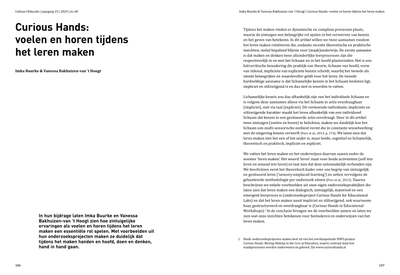Designing meaningful audio for interactive applications such as video games or sonic user interfaces, presents designers with several challenges. One challenge is the fact that the perception of musical meaning involves cultural or learned aspects when it comes to tonality (Huron, 2006; Patel, 2008). For applied music and sound design, as cross-cultural phenomenon, this cultural specificity appears to be a significant disadvantage. Nevertheless, the history of interactive music in video games and sonic user interfaces illuminates many successful examples of meaningful musical icons in classic arcade games such as Pac-Man (1980), Donkey Kong (1981), Super Mario World (1990) and Pong (1972) and the user interface sounds of operating systems.
LINK
In hun bijdrage laten Imka Buurke en Vanessa Bakhuizen-van ’t Hoogt zien hoe zintuigelijke ervaringen als voelen en horen tijdens het leren maken een essentiële rol spelen. Met voorbeelden uit hun onderzoeksprojecten maken ze duidelijk dat tijdens het maken handen en hoofd, doen en denken, hand in hand gaan
MULTIFILE

We need mental and physical reference points. We need physical reference points such as signposts to show us which way to go, for example to the airport or the hospital, and we need reference points to show us where we are. Why? If you don’t know where you are, it’s quite a difficult job to find your way, thus landmarks and “lieux de memoire” play an important role in our lives.
LINK